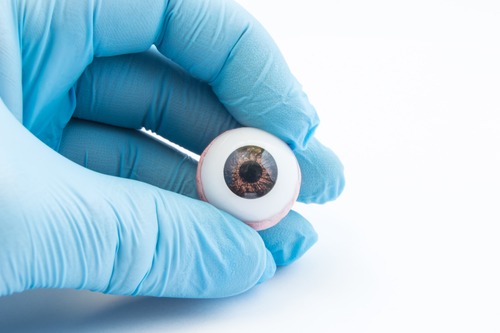Enucleation & Evisceration
 Nobody wants to lose their eye. However, in some cases it may become necessary. You should know that just because you lost your eye, doesn’t mean you cannot lead a normal and active life. These are a few things you can expect during an enucleation or evisceration.
Nobody wants to lose their eye. However, in some cases it may become necessary. You should know that just because you lost your eye, doesn’t mean you cannot lead a normal and active life. These are a few things you can expect during an enucleation or evisceration.
Khan Eyelid and Facial Aesthetics, led by board certified ophthalmologist and eye surgeon Dr. Tanya Khan provides safe and proven eye care procedures to patients in Plano, Dallas, Texas, and surrounding communities.
Understanding Enucleation
Enucleation refers to the surgical removal of the eyeball. Surrounding tissues are left in place when the eyeball is removed. The eyeball is usually replaced with a small ball of silicone, glass, plastic, or rubber. The procedure is performed when the injured or diseases eye is beyond repair.
Understanding Evisceration
Evisceration of the eye generally involves removing the contents of the cornea and the eye. The sclera is left in place in this procedure, which is the outer white covering of the eye.
Who Needs Enucleation or Evisceration?
There are several different diseases and injuries that may require evisceration or enucleation. These include:
Infection
An eye can sometimes become so severely infected that there is no way for it to be healed. In such a case, the eye will need to be removed for preventing infection from spreading to other parts in the body. Evisceration is performed in most cases to prevent the spread of infection.
Tumor
Enucleation may be required when a cancerous growth within the eye is untreatable. This procedure is performed for stopping the spread of cancer.
Painful Eye or Blind Eye
All blind eyes don’t need to be removed. However, enucleation may be necessary if the eye causes pain. Blind eyes may become painful because of inflammation, pressure, and other reasons. Enucleation may be the last resort.
Unpleasant Looking Blind Eye
The eye made need to be removed if it becomes cosmetically unacceptable. This can be because it shrinks or some other cause. Scleral shell is generally used for fixing this problem. It acts as a large contact lens that resembles the eye. Scleral shell may become uncomfortable for some patients who may elect to have their eye removed.
Steps to Take After Removing the Eye
An implant may be placed within the remaining scleral shell or in the empty space. This allows the remaining ocular muscles to function and also replaces missing volume within the socket. The implant is not eye prosthesis and cannot provide cosmetic enhancement. The socket will appear pink behind the eyelids as tissues will grow over the implants.
You should be able to start using an artificial eye or eye prosthesis when the socket heals completely. The prosthetic eye would be molded to fit perfectly within the eye socket. You should get in touch with an experienced and trained oculoplastic surgeon if you are looking to have an enucleation or evisceration performed on your eye.
Oculoplastic and reconstructive surgeon Dr. Tanya Khan receives patients from Plano, Dallas, Texas, and nearby areas for advanced and innovative eye care procedures.
Contact Khan Eyelid and Facial Aesthetics and Oculoplastic & Reconstructive Surgeon Dr. Tanya Khan Today to Schedule an Appointment
For more information about procedures and treatments at Khan Eyelid and Facial Aesthetics by Ophthalmic surgeon Dr. Tanya Khan. Click here to contact us.
Taking patients from in and around Dallas, Plano, Fort Worth, Grapevine, Garland, Mesquite, Carrollton, Irving, Frisco, Texas and more.









Schedule a Consultation: 972-EYE-LIDS (393-5437)